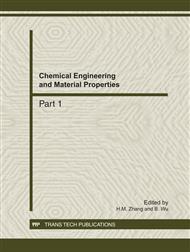[1]
Drofenik, M., et al. J. Appl. Phys. Vol. 82 (1997)pp.333-340.
Google Scholar
[2]
Z. Q. Han. J Magn Mater Devices, Vol. 41 (2010)pp.1-11.
Google Scholar
[3]
M. Sisk, I. Kilbride, A.J. Barker. J. Mater. Sci. Lett, Vol. 14 (1995)pp.153-154.
Google Scholar
[4]
Andre Angermann, J. T. pfer. Ceramics International, Vol. 37 (2011)pp.995-998.
Google Scholar
[5]
C. F. Zhang, X. C. Zhong, H. Y. Yu, et al. Physica B, Vol. 404 (2009)pp.2327-2329.
Google Scholar
[6]
C. J. Liu, Y. Wei, S. L. Hao, et al. J Magn Mater Devices, Vol. 139 (2008)pp.51-53.
Google Scholar
[7]
C. Xue, G. Liu, Y. M. Wang, et al. Journal of Alloys and Compounds, Vol. 497 (2010)pp.9-12.
Google Scholar
[8]
C. Rath, K.K. Sahu, S. Anand, et al. Journal of Magnetism and Magnetic Materials, Vol. 202 (1999)pp.77-84.
Google Scholar
[9]
Y. Yamamoto, A. Makino. J. Magn. Magn. Mater. Vol. 133 (1994)pp.500-503.
Google Scholar
[10]
X. Wang, Y. F. Cui, Y. M. Wang, et al. Rare Metals, Vol. 25 (2006)pp.526-529.
Google Scholar
[11]
H. Waqas, A. H. Qureshi. J Therm Anal Calorim, Vol. 200 (2010)pp.529-535.
Google Scholar
[12]
P. Mathur, A. Thakur, M. Singh. J Mater Sci, Vol. 42 (2007)pp.8189-8192.
Google Scholar
[13]
G. C. Xu, L. D. Zhang. Nanometer Compound Materials, (Chemical industry press, China 2002).
Google Scholar
[14]
B. W. Li. Beijing: Beijing University of Technology, (2006).
Google Scholar
[15]
P. Liu. M. S. Dissertation, Tianjin: Tianjin University, ( 2006).
Google Scholar
[16]
G. F. Hua, Y. F. Liu, J. Chen, et al. Chemical Research, Vol. 14 (2003)pp.9-12.
Google Scholar
[17]
H. Y. Gong, Y. S. Yin, X. Wang, et al. Materials Research Bulletin, Vol. 39 (2004)pp.513-521.
Google Scholar
[18]
Y. F. Cui, X. Wang, Y. Wei, et al. Journal of Synthetic Crystals, Vol. 34 (2005)pp.1096-1099.
Google Scholar
[19]
B. D. Cullity. Elements of X-ray Diffraction. Addison-Wesley, Reading, MA, (1987. ).
Google Scholar
[20]
X. M. Zhou. Journal of the Chinese Rare Earth Society, Vol. 20 (2002)pp.67-69.
Google Scholar
[21]
Y. L. Wang, Y. Huang, L. Yan, et al. Bulletin of the Chinese Ceramic Society, Vol. 25 (2006)pp.83-88.
Google Scholar
[22]
Z. X. Yue, J. Zhou, H. G. Zhang, et al. Journal of the Chinese Ceramic Society, Vol. 27 (1999)pp.466-470.
Google Scholar


